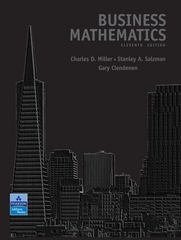Question
1) Consider the following three-year project. The initial after-tax outlay or after-tax cost is $1,500,000. The future after-tax cash inflows for years 1, 2, 3
1) Consider the following three-year project. The initial after-tax outlay or after-tax cost is $1,500,000. The future after-tax cash inflows for years 1, 2, 3 and 4 are: $800,000, $800,000, $300,000 and $100,000, respectively. What is the payback period without discounting cash flows?
A) 1.875 years
B) 2.0 years
C) 3.5 years
D) 4.125 years
2) The initial outlay or cost for a four-year project is $1,100,000. The respective cash inflows for years 1, 2, 3 and 4 are: $500,000, $300,000, $300,000 and $300,000. What is the discounted payback period if the discount rate is 10%?
A) About 2.67 years
B) About 3.35 years
C) About 3.84 years
D) About 3.98 years
3) Frameworks, Inc. is considering a five-year project that has an initial after-tax outlay or after-tax cost of $80,000. The respective future cash inflows from its project for years 1, 2, 3, 4 and 5 are: $15,000, $25,000, $35,000, $45,000 and $55,000. Frameworks uses the net present value method and has a discount rate of 9%. Will Frameworks accept the project?
A) Frameworks accepts the project because the NPV is $129,455.25.
B) Frameworks accepts the project because the NPV is 79,455.25.
C) Frameworks accepts the project because the NPV is $49,455.25.
D) Frameworks accepts the project because the NPV is less than zero.
It would be great if the answers is included the calculation. Thank you!
Step by Step Solution
There are 3 Steps involved in it
Step: 1

Get Instant Access to Expert-Tailored Solutions
See step-by-step solutions with expert insights and AI powered tools for academic success
Step: 2

Step: 3

Ace Your Homework with AI
Get the answers you need in no time with our AI-driven, step-by-step assistance
Get Started


